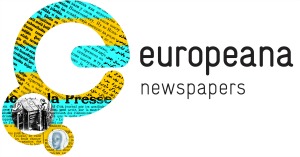On 16 October 2014, the Austrian National Library hosted the Austrian Information Day of the Europeana Newspapers Project. The event was structured around the theme of Digitised, Historic Newspapers as a Source (Die digitalisierte, historische Zeitungen als Quelle) and enabled the participants to examine this source from very different angles.
The programme was tailored to attract end-users coming from backgrounds as diverse as the topics in a newspaper issue itself. Besides attendees from different Austrian universities and university libraries, teachers and students were welcomed at the event as well. Eight presentations were held throughout the Information Day, each highlighting another aspect of newspapers digitisation.
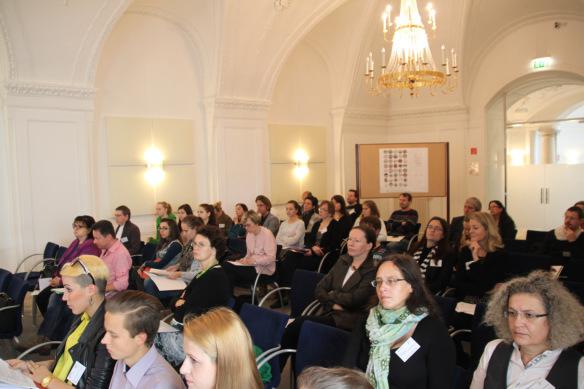
The Current State of Newspaper Digitisation
Hans-Jörg Lieder of the Staatsbibliothek zu Berlin not only introduced the Europeana Newspapers Project to the audience, but he also put the project into a wider perspective, examining the current state of newspaper digitisation. His conclusion that the present situation of newspaper digitisation is best illustrated by a photo taken shortly after the start of a marathon proved to be very thought provoking and was widely discussed.
His talk was followed by Christa Müller, head of the Austrian National Library’s digitisation department ‘Abteilung Digitale Services’. She focused on ANNO, the newspaper portal of the Austrian National Library. About 13 million newspaper pages are currently available online, of which about four million pages are searchable. Christa Müller also delivered insight into the selection process for digitisation and the planned functionalities of ANNO.
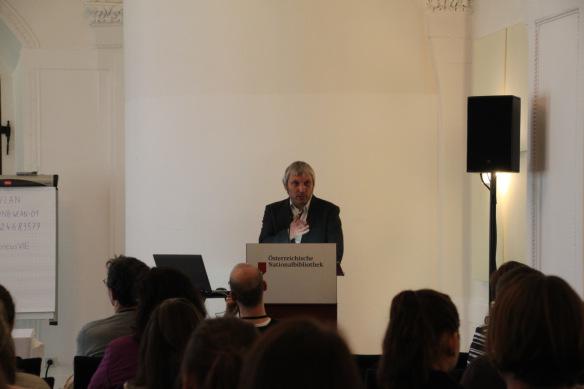
Günter Mühlberger of the University of Innsbruck, a technical project partner in Europeana Newspapers, gave an overview of the different stages involved in digitisation projects. While the emphasis was placed on technical aspects – OCR, quality of digital image, metadata – he also touched upon other areas such as the legal situation of historical newspapers or the archiving the digitised material.
Digitised, Historical Newspapers as a Source for Historical Research
After the coffee break two historians provided insights into their day to day work with digitised, historical newspapers.
Professor Oliver Rathkolb, who heads the Institute of Contemporary History (Institut für Zeitgeschichte) at the University of Vienna, pointed out how he was able to utilise digitised, historical newspapers in his own research. He especially highlighted that he was now able to work more significantly more efficiently, and at the same time was able to find material that had until now been undiscovered.
Rathkolb also emphasised the importance of bringing more recent historical newspapers online, for example those relating to the period between the First and Second World War.
The following talk by Dr Marie-Theres Arnbom — a freelance historian, author, curator and cultural manager — outlined how the portal ANNO helped her research using the example of a biography. She chose Victor Léon, a librettist, to illustrate how she was able to find details about his life she would have never discovered. She said that with the help of such portals as ANNO it is possible to reconstruct a whole life.
Both speakers cooperated with the Austrian National Library to digitise additional material. This shows that the relationship between memory institutions and researchers can be fruitful for both sides. Seeing how digitised material was used in actual research sparked great interest within the audience.
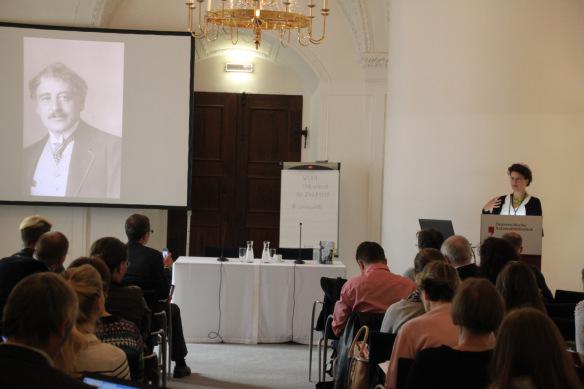
The Versatility of Digitised, Historic Newspapers
Lunch was followed by three talks – all diverse in content but oriented on practical aspects.
Clemens Neudecker of the Staatsbibliothek zu Berlin investigated the problems but also opportunities when using digitised newspapers as a base for research in Digital Humanities. He pointed out that a term such as ‘Big Data’ is also relative. After all, only an estimated four percent of European holdings have been digitised so far.
His talk was followed by Eva Maria Naimer. She shared her experiences of employing digitised newspapers in secondary school teaching – an especially exciting application of the content made available through newspaper portals. Eva Maria Naimer showed how different topics, such as censorship and the changing image of women can be illustrated by examples of newspaper articles. The following lively discussion engaged in topics such as if really all content should be made available to students – a topic which has seldom been discussed in connection with newspapers digitisation so far.
Martin Schaller, who held the last talk at the Information Day, gave an overview of different online newspaper portals, highlighting especially the content browser developed within the project.
Following the last presentation, the audience had the possibility for an in-depth discussion of their questions in three more informal Q&A sessions.
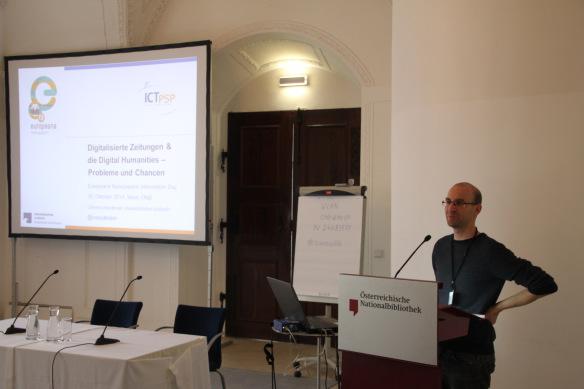
Key messages of the Information Day
The Information Day was well received amongst participants. The talks emphasising the use of digitised newspapers were especially heavily debated, sparking interesting questions and further contemplation. The relevant examples highlighting how this source is actually utilised, not only in historical research but in teaching as well, gave the audience an impression of its versatility. However, newspaper digitisation is only in its beginnings and more work, especially in increasing the results of Optical Character Recognition or introducing Named Entity Recognition, needs to be done. To use Hans-Jörg Lieder’s metaphor mentioned in his talk: The starting shot just faded away, now we need to keep going.

The event was covered in social media, especially on Twitter. Tweets #eurnewsVIE show comments on talks.
